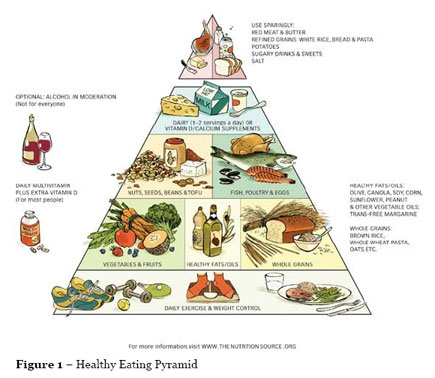Understanding basic nutritional concepts and the components of a healthy diet is important to everyone. Proper nutrition is vital to an individual’s health and wellness as well as peak athletic performance. Major causes of death and disease are intimately linked to poor diet and a lack of physical activity[1], and an inadequate diet is associated with several chronic diseases including heart disease[2], certain cancers[3,4], hypertension, Type II diabetes[5] and osteoporosis.[6] Given the importance of optimal nutrition to health and longevity; it is important to gain knowledge of proper nutrition and dietary habits. The objectives of this section are to specifically explore basic nutritional concepts and recommendations and dietary supplements and how they relate to maintaining health and longevity.
Nutrition Terms
Diet is a term used to describe the foods and beverages we consume, whereas a nutrient is any substance found in food and beverages that can be used by the human body for energy, building tissue or regulating bodily functions. Essential components to optimal health and wellness must be obtained through the diet and cannot be made by the body. The term macronutrient is used to describe nutrients needed in large amounts such as carbohydrates, protein and fats. Vitamins and minerals are considered micronutrients because they are required in smaller amounts.
Dietary Guidelines for Americans
The Dietary Guidelines for Americans (DGA) are based on peer-reviewed, scientific data and are updated every five years by the United States Department of Agriculture and the Department of Health and Human Services (USDA-DHHS). The goal of these recommendations is to promote health and prevent major chronic diseases such as cardiovascular disease and osteoporosis. The top causes of death in the United States are linked to a poor diet, lack of physical activity and excessive calorie intake. The take home message of the DGA is to encourage Americans to eat less, move more and make wiser food choices.
Making Wise Choices
Making wise food choices includes consuming a wide variety of nutrient-dense foods such as whole grains, fruits, vegetables, legumes and lean protein. Saturated and Trans fats, salt, cholesterol, sugar and alcohol should be limited. To prevent unwanted weight gain, calorie intake should be equal to calories expended. This can be accomplished by adopting eating patterns established by the Food Guide Pyramid or Dietary Approaches to Stop Hypertension (DASH) diet. Both plans have a wide range of calorie levels that meet the needs of various age and gender groups. The DGA also recommends regular physical activity while minimizing sedentary behaviors.
An alternative approach to the USDA’s food guide pyramid is the Healthy Eating Pyramid, created by the Harvard School of Public Health.[7] This pyramid addresses the shortcomings of the Food Guide Pyramid by distinguishing between whole grains and refined, processed foods, separating red meat from other protein sources and emphasizing healthy fats. Furthermore, the Healthy Eating pyramid is grounded in daily exercise in conjunction with weight control and incorporates alcohol in moderation. The Healthy Eating pyramid recognizes the value of a daily multivitamin to make up for dietary shortcomings and vitamin D/calcium supplements, nutrients most Americans are lacking due cultural food preferences, poor food choices or lactose intolerance (the inability to breakdown milk sugar).

Understanding What We Eat
Despite the numerous and widespread guidelines for adopting a healthy diet, most people miss the mark. Only three percent of the U.S. population meets four of the five recommendations for the intake of fruits, vegetables, grains, milk products, meat and bean food groups.[8] In a 2005 national survey of fruit and vegetable intake, 76 percent of Americans consumed less than the recommended five or more servings of fruits and vegetables per day. In contrast, the top five consumed foods among Americans include 1) sugared beverages; 2) cake and sweet rolls; 3) hamburgers; 4) pizza; 5) potato and corn chips.[9] These items are high in added sugars, fat, salt and calories which experts agree should be consumed in limited amounts. It is imperative to recognize that eating these foods frequently is indicative of poor dietary habits which ultimately lead to excessive calorie intake, inadequate nutrient intake, unwanted weight gain and related health problems.
The Nutrients
There are six classes of nutrients:
- Carbohydrates
- Proteins
- Lipids – fats and oils
- Vitamins
- Minerals
- Water
Normal growth, development and optimal functioning of the human body require 45 essential nutrients that must be supplied by the diet. Essential nutrients are needed by the body but are not produced by the body. A low intake of any of the essential nutrients increases the risk of developing a deficiency or adverse changes in health.
References
1 James WP. The epidemiology of obesity: the size of the problem. J Intern Med. 2008 Apr;263(4):336-52. Epub 2008 Feb 27. Review.
2 Getz GS, Reardon CA. Nutrition and cardiovascular disease. Arterioscler Thromb Vasc Biol. 2007 Dec;27(12):2499-506. Epub 2007 Oct 22. Review.
3 Rohrmann S, Giovannucci E, Willett WC, Platz EA. Fruit and vegetable consumption, intake of micronutrients, and benign prostatic hyperplasia in US men. Am J Clin Nutr. 2007 Feb;85(2):523-9.
4 Chao A, Thun MJ, Connell CJ, McCullough ML, Jacobs EJ, Flanders WD, Rodriguez C, Sinha R, Calle EE. Meat consumption and risk of colorectal cancer. JAMA. 2005 Jan 12;293(2):172-82.
5 Astrup A, Dyerberg J, Selleck M, Stender S. Nutrition transition and its relationship to the development of obesity and related chronic diseases. Obes Rev. 2008 Mar;9 Suppl 1:48-52. Review.
6 Dawson-Hughes B, Bischoff-Ferrari HA. Therapy of osteoporosis with calcium and vitamin D. J Bone Miner Res. 2007 Dec;22 Suppl 2:V59-63. Review.
7 “The Nutrition Source Food Pyramids: What Should You Really Eat?” www.hsph.harvard.edu. 2008. Harvard School of Public Health. 15 Jul. 2008. <http://www.hsph.harvard.edu/nutritionsource/what-should-you-eat/pyramid-full-story/index.html>
8 Nielsen SJ, Siega-Riz AM, Popkin BM. Trends in energy intake in U.S. between 1977 and 1996: similar shifts seen across age groups. Obes Res. 2002 May;10(5):370-8.
9 1999-2000 National Health and Nutrition Examination Survey (NHANES)
Nielsen SJ, Popkin BM. Patterns and trends in food portion sizes, 1977-1998. JAMA. 2003 Jan 22-29;289(4):450-3.